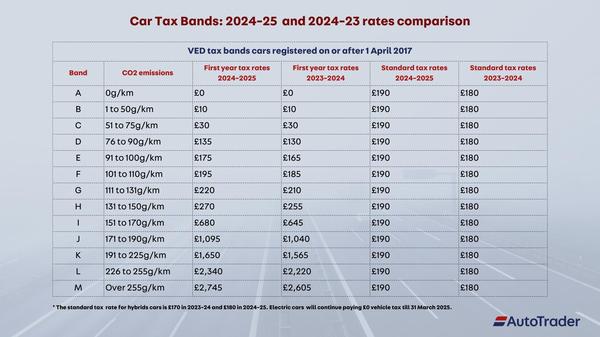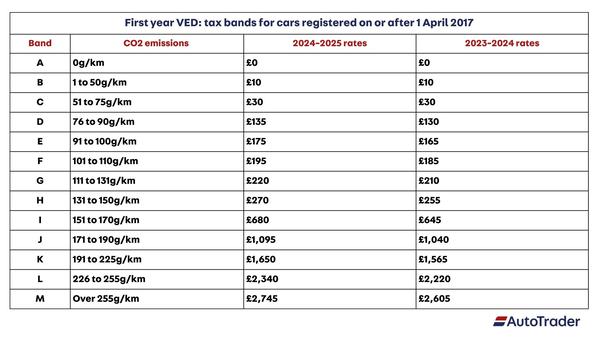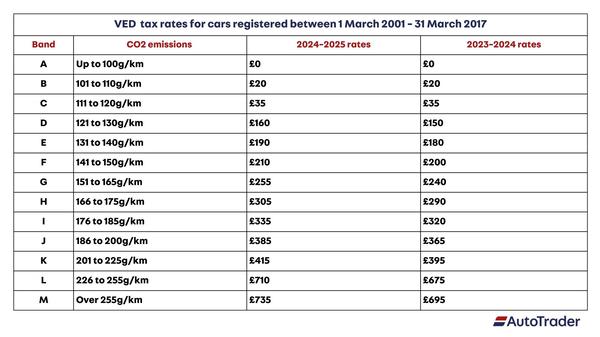Advice
Vehicle excise duty: car tax band rates - 2024-25 update
Find out how VED tax bands work and how much tax you’ll pay for a new or used car in the upcoming 2024-25 financial year.


Words by: Andrew Woodhouse

Additional words by: Nimisha Jain
Last updated on 26 March 2024 | 0 min read
Everyone in the UK needs to pay Vehicle Excise Duty, or VED, if they drive on the public roads. VED is also known as vehicle tax, car tax, road tax or showroom tax.
All cars must be registered for tax, though there are some exemptions to paying the tax. There are different tax bands that cars fall in – your tax band will depend on your vehicle’s age and CO2 emissions. Bigger, older engines tend to produce more CO2, and so you pay more tax on them.
All cars must be registered for tax, though there are some exemptions to paying the tax. There are different tax bands that cars fall in – your tax band will depend on your vehicle’s age and CO2 emissions. Bigger, older engines tend to produce more CO2, and so you pay more tax on them.
New VED rates 2024-25
During the Spring Budget 2024, the Chancellor announced that Vehicle Excise Duty will be increasing from 1 April 2024 onwards. VED has been increasing since 2010 in line with inflation.
To find out how much tax you need to pay for your vehicle in 2024-2025, you’ll need to know when your car was first registered and what fuel type is your car: • Cars registered on or after 1 April 2017 • Cars registered between 1 March 2001 – 31 March 2017 • Cars registered before 1 March 2001 Other factors may also affect the amount of tax you pay: • Was your car priced over £40,000? You may have to pay additional tax • Certain cars are tax exempt – does your car fall in this category? • Taxes work differently for vans, so if you drive a van, find out how much tax you owe here
To find out how much tax you need to pay for your vehicle in 2024-2025, you’ll need to know when your car was first registered and what fuel type is your car: • Cars registered on or after 1 April 2017 • Cars registered between 1 March 2001 – 31 March 2017 • Cars registered before 1 March 2001 Other factors may also affect the amount of tax you pay: • Was your car priced over £40,000? You may have to pay additional tax • Certain cars are tax exempt – does your car fall in this category? • Taxes work differently for vans, so if you drive a van, find out how much tax you owe here
If your car was registered on or after 1 April 2017, you’ll have to pay the first 12 months of tax when your vehicle is first registered. After this, you’ll pay the standard rate of tax every year.
Standard rate VED for cars (applicable from second tax year onwards):
For the financial year 2024-23, the standard rate applicable to all petrol and diesel cars is £190, while alternatively fuelled cars like hybrid cars will benefit from a lower standard rate of £180. If you drive a fully electric car, you’ll pay £0 standard tax till 31 March 2025, but remember - you still need to register your vehicle as taxed with the DVLA.First-year VED in 2024-25:
If this is the first time you’re paying tax on your car, the first-year VED rates will be as follows: • Band A: Cars that produce 0g/km of CO2 will pay £0 in VED (you’ll still need to register the vehicle as taxed) • Band B: Cars that produce 1-50g/km of CO2 pay £10 • Band C: Cars that produce 51-75g/km of CO2 pay £30 • Band D: Cars that produce 76-90g/km of CO2 pay £135 • Band E: Cars that produce 91-100g/km of CO2 pay £175 • Band F: Cars that produce 101-110g/km of CO2 pay £195 • Band G: Cars that produce 111-130g/km of CO2 pay £220 • Band H: Cars that produce 131-150g/km of CO2 pay £270 • Band I: Cars that produce 151-170g/km of CO2 pay £680 • Band J: Cars that produce 171-190g/km of CO2 pay £1,095 • Band K: Cars that produce 191-225g/km of CO2 pay £1,650 • Band L: Cars that produce 226-255g/km of CO2 pay £2,340 • Band M: Cars that produce anything above 255g/km of CO2 pay £2,745 as the first-year rate Bear in mind, if you drive a diesel car that doesn’t meet the Real Driving Emissions 2 (RDE2) standards, you will have to pay higher first-year VED which mean your tax bracket will fall in one higher Band rate than it would’ve with a RDE2 compliant diesel car. Fully electric cars fall under VED Band A: cars that produce 0g/km of CO2; so, the first year tax rate will be £0 till 2025. First-year VED tax rate has increased in 2024-25. Here's a comparison between the 2023-24 and 2024-25 rates to find out how much more you'll be paying:
Cars registered between 1 March 2001 and 31 March 2017 are banded according to their CO2 emissions.
VED rates for cars registered between 1 March 2001 – 31 March 2017 are as follows in financial year 2024-25: • Band A: Cars that produce 0-100 g/km of CO2 will pay £0 in VED (you’ll still need to register the vehicle as taxed) • Band B: Cars that produce 101-110 g/km of CO2 now have a first-year rate of £20 • Band C: Cars that produce 111-120 g/km now have a first-year rate of £35 • Band D: Cars that produce 121-130 g/km now have a first-year rate of £160 • Band E: Cars that produce 131-140 g/km now have a first-year rate of £190 • Band F: Cars that produce 141-150 g/km now have a first-year rate of £210 • Band G: Cars that produce 151-165 g/km now have a first-year rate of £255 • Band H: Cars that produce 166-175 g/km now have a first-year rate of £305 • Band I: Cars that produce 176-185 g/km now have a first-year rate of £335 • Band J: Cars that produce 186-200 g/km now have a first-year rate of £385 • Band K: Cars that produce 201-225 g/km now have a first-year rate of £415 • Band L: Cars that produce 226-255g/km now have a first-year rate of £710 • Band M: Cars that produce anything above 255g/km now have a first-year rate of £735 In the financial year 2024-35, VED rates for cars registered between 1 March 2001 – 31 March 2017 have changed. Here's how much more you'll be paying in 2024-25 as compared to 2023-24:
VED rates for cars registered between 1 March 2001 – 31 March 2017 are as follows in financial year 2024-25: • Band A: Cars that produce 0-100 g/km of CO2 will pay £0 in VED (you’ll still need to register the vehicle as taxed) • Band B: Cars that produce 101-110 g/km of CO2 now have a first-year rate of £20 • Band C: Cars that produce 111-120 g/km now have a first-year rate of £35 • Band D: Cars that produce 121-130 g/km now have a first-year rate of £160 • Band E: Cars that produce 131-140 g/km now have a first-year rate of £190 • Band F: Cars that produce 141-150 g/km now have a first-year rate of £210 • Band G: Cars that produce 151-165 g/km now have a first-year rate of £255 • Band H: Cars that produce 166-175 g/km now have a first-year rate of £305 • Band I: Cars that produce 176-185 g/km now have a first-year rate of £335 • Band J: Cars that produce 186-200 g/km now have a first-year rate of £385 • Band K: Cars that produce 201-225 g/km now have a first-year rate of £415 • Band L: Cars that produce 226-255g/km now have a first-year rate of £710 • Band M: Cars that produce anything above 255g/km now have a first-year rate of £735 In the financial year 2024-35, VED rates for cars registered between 1 March 2001 – 31 March 2017 have changed. Here's how much more you'll be paying in 2024-25 as compared to 2023-24:

VED for cars registered before 1 March 2001 is based on the engine size. Your vehicle handbook will tell you the exact capacity of your engine.
If your vehicle’s engine is 1549cc or smaller, the tax rate for the year 2024-25 is £210. For cars with an engine over 1549cc, you’ll have to pay £345 in 2024-25.
If your vehicle’s engine is 1549cc or smaller, the tax rate for the year 2024-25 is £210. For cars with an engine over 1549cc, you’ll have to pay £345 in 2024-25.
If your new car has a list price of more than £40,000, you’ll pay an additional rate or premium car tax. In financial year 2024-25, this premium tax is £410. This kicks in when you pay your second lot of VED (i.e. after the first year is complete) and is payable on top of the standard rate of VED.
You’ll pay this for the first five years after the car’s registration. Electric cars are exempt from paying additional rate tax this year. The rate of VED is calculated on the list price of a car, so it’ll include any options you add. If you’re buying a £39,000 car and pop a few extras on, you could send the list price over £40,000 and be subject to the £410 supplement.
You’ll pay this for the first five years after the car’s registration. Electric cars are exempt from paying additional rate tax this year. The rate of VED is calculated on the list price of a car, so it’ll include any options you add. If you’re buying a £39,000 car and pop a few extras on, you could send the list price over £40,000 and be subject to the £410 supplement.
Some cars are tax exempt, but you still need to register their tax with the DVLA for them:
1. Fully electric cars
Electric cars are exempt from paying any taxes till 31 March 2025. This includes the premium tax paid on cars priced above £40,000. Learn more VED rates for used and new electric cars from 2025 onwards .2. Drivers with disabilities
Drivers with disabilities may also be entitled to free VED if they meet the following criteria: • Use a mobility scooter or similar • Receive the Disability Living Allowance mobility component’s higher rate • Receive a War Pensioner’s Mobility Supplement More information is available on Gov.uk.3. Historic cars
If a car is over 40 years old (from their date of manufacture, not date of first registration) then it can be classed as tax exempt. The exemption comes into effect every April, so April 2021 saw all cars built prior to 1 January 1981 become exempt. To be exempt, your car will need to be classified as a historic vehicle. You can do this at a Post Office, and you’ll need to take: • your log book (V5C form – needs to be in your name) • a vehicle tax reminder letter (V11 form) • a valid MOT certificate or evidence your car is MOT-exempt (V112 form)4. SORN cars
If you don’t drive your car anymore, and you’ve declared it as SORN, you’re not required to pay taxes on it. If you’ve already paid VED for the car and it has been declared SORN, you’ll get a refund for the rest of that time.Taxes work differently for vans. Find out how much tax you owe if you drive a van.
Interested in buying a low tax car? Browse from thousands of used and new electric cars on Auto Trader and benefit from zero tax till 2025.
Interested in buying a low tax car? Browse from thousands of used and new electric cars on Auto Trader and benefit from zero tax till 2025.